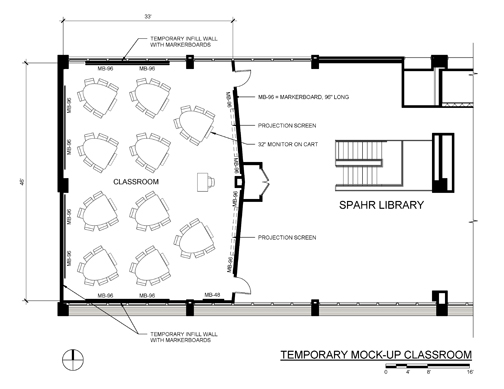Portion of Spahr Library Converted to “Active-Learning” Classroom

A sneak preview of a new learning environment at the University of Kansas School of Engineering is now open in Spahr Library.
During winter break, the west end of the library’s second floor was converted into a 46-foot by 33-foot classroom that offers students and faculty members an opportunity to experiment with a type of learning space that will be featured in the Learned Engineering Expansion Phase 2 (LEEP2) building, set to open in fall 2015.
The redesigned classroom is part of a movement away from traditional teaching methods toward an active-learning model designed to better utilize classroom time.
“We’ve known for a long time that sitting in class and taking notes in a static environment is not an effective use of classroom time,” said JoAnn Browning, associate dean for administration in the School of Engineering. “We want to provide information and allow students to work out the problems themselves while they are together.”
The temporary, mock-up classroom in Spahr Engineering Library will have 10 semi-circular tables that encourage group work and active learning. A monitor can be placed at each table allowing students to plug in their laptops, collaborate on problem solving, share solutions with their peers, and communicate written information with their professor. Content from the professor’s computer can be shared with the class using two overhead projectors and the monitors at each table. Or student work from a single table can be shared with the entire class. The walls are adorned with large white boards to provide ample space for taking notes and initiating discussion.
“This setup encourages students to utilize all resources in the classroom and ask questions of their peers and the professor” Browning said. “Research shows this type of active engagement works and is the most effective use of that classroom time.”
Only five classes will be held in the space during the spring semester. Browning said the number is limited to provide more free time for all faculty and students to explore the classroom and experiment with its features as well as use it for studying. Plans call for the new engineering building to have six active-learning classrooms: three 60-person rooms, one 90-person room, one 120-person room, and another for 180 people.
“We want to do everything we can to ensure we are ready to utilize the new classrooms in LEEP2 on day one. We want everyone prepared to take advantage of all these classrooms have to offer,” Browning said. “Since we’ve never attempted this type of learning environment, we also understand it’s critical to gather as much input as possible before opening the classrooms in LEEP2. We want to know what works and what’s not ideal so we can tailor those facilities to meet the specific needs of our students and faculty.”
The space in Spahr Engineering Library will be configured as a classroom for the spring and fall semesters of 2014. At the conclusion of the fall semester, the classroom will be removed as construction begins on transition space between the new building and Spahr Library’s west end. The space will eventually become enhanced study area for students.
Students with classes that have been reassigned to the new Spahr Library classroom will receive additional details from their professors. Spring 2014 courses that will use the classroom are:
|
|
|
|
|
|
|
|
|
|
|
|
|
|
|
|
|
|